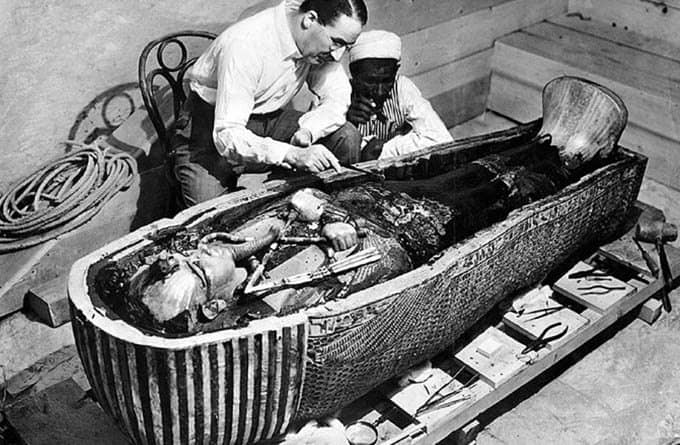BLOG
INTERESTING STUFF
THAT CAUGHT OUR EYE
Sovereign Wealth Summit at Downton Abbey: The True Story Behind the Facade

I was invited to attend the “Sovereign Wealth Summit”, run by Dan Kennedy, the highest paid marketing man in the world who’s known in the business as “No Bullshit” for his straight talking.
We discussed how the world’s wealthiest people like to be treated, how they do business and what they expect in levels of service. They demand work with the best and highest standards; they want to showcase this in their own homes.
How appropriate that the backdrop for this meeting was Highclere Castle, or as you know it, Downton Abbey. As we explored the ornate country house I found that the Canarvon family were precisely the sort of clientèle we were discussing – right down to some truly brilliant eccentricities.
Highclere Castle is the quintessential image of British wealth and the lifestyle it can afford, which is precisely why it was chosen to become Downton Abbey. But this is a facade; the result of a top-to-bottom renovation by Charles Barry, the acclaimed architect of none other than the Houses of Parliament. A celebrity architect doesn’t come cheap but the 3rd Earl of Canarvon was not shy to show his wealth.
Before its Westminster-esque remodelling, Highclere Castle was a typical Georgian mansion, but this no longer satisfied the Earl. The role of the country house had transformed in the 1800s when the advent of railways made it far easier to arrange huge social gatherings – a precursor to the ease of socialising that we now take for granted. More guests meant more rooms, more servants and more “wow factor”.
I imagine the interactions between Charles Barry and the Earl as a grander version of my client meetings. After all, the Earl’s needs were very familiar: take rather plain Georgian house and give it a contemporary facelift (for the time) and clear away walls to form open spaces that show off the scale and quality of the building.
I followed in the footsteps of the Earl’s esteemed guests and the powerful social statement Charles Barry had made with the redesign is just as effective today as it was in the 1800s.
After being awed by the imposing towers, fashionable Gothic detailing and beautiful landscaped gardens we were taken through to an almost cathedral-like entrance of arches, columns and a triple height hall, complete with a vaulted ceiling, ribbed like the bones of a colossal beast.

Such a vast estate also had to be designed with an intricate network of halls that allowed their many maids to carry out their duties while remaining largely invisible. My clients also expect that the inner workings to remain unseen, except in this case the inner workings were human.
Unlike Buckingham Palace, which I found to have odd and messy architecture, Highclere Castle is a stunningly successful renovation. Like much of Barry’s work, it borrowed the best of Italian Renaissance flair to create a style that – despite its roots – has become quintessentially British, especially now that Downton Abbey has become a global sensation.
Now, on to the mummies.
The 5th Earl of Carnarvon was the very definition of a wealthy eccentric, with a love for fast horses, cars and plundering the tombs of ancient Egypt. You may know him better as George Herbert, who alongside Howard Carter opened the tomb of Tutankhamen in the Valley of the Kings.
He afforded this lifestyle through a classic aristocratic power marriage with Almina Victoria Maria Alexandra Wombwell, the illegitimate daughter of Afred de Rothschild of the Rothschild banking fortune who came with a £50 million dowry – billions in today’s money.
Herbert spent much of his time at the luxurious Sofitel Winter Palace Hotel on the banks of Nile so that he could accompany his teams of archaeologists. Unfortunately, their finds weren’t substantial enough to recoup his costs and – even with his colossal wealth – Herbert was burning through his money.
Desperate for results, Herbert turned to budding archaeologist Howard Carter, a self made man with no formal education who made a name for himself thanks to his passion and skill. However, despite numerous historically important discoveries, Carter’s excavations weren’t uncovering anything valuable enough to give Herbert his return on investment.
In a pivotal meeting in the halls of Highclere Castle, Herbert told Carter he was cutting him off. But Carter was convinced there was more to be found and managed to persuade the frustrated Earl to fund just one more expedition.
And it’s a good thing he did. That final expedition proved to be the most famous archaeological discovery of the century. In 1923 Carter, Herbert and his wife finally opened the tomb of Tutankhamen, whose glorious, iconic coffin resulted in a surge of interest in Egyptian archaeology across the globe.

Unfortunately, Herbert wasn’t able to enjoy his restored wealth. Two months later, he died suddenly from an infected mosquito bite, giving rise to mythical curse of Tutankhamen. Carter, seemingly immune to such curses, continued his career in archaeology with the financial backing of Almina Herbert, who swiftly remarried and lived a long life of scandal, spending and bankruptcy.
Today, Herbert’s Egyptian legacy can be found in the basement, where the current Earl and Countess of Carnarvon host an exhibition that follows his Egyptian adventures complete with artefacts and replicas from his discoveries, including a stunning recreation of the tomb of Tutankhamen.
What better after-dinner show stopper is there than taking your guests down to a basement full of mummies? Despite some fantastical client requests I’ve had over the years, nothing’s quite come close to that.
I would, however, love to give it a try. If you have a collection of sarcophagi that you’re keen to display, call DGA today on 0208 874 4688 to find out how we can elegantly integrate Egyptian treasures into your home.
John Dyer-Grimes
